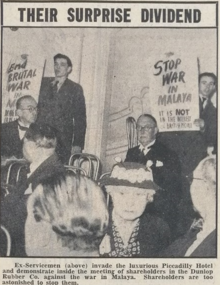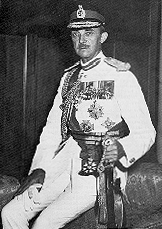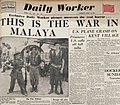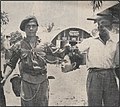British Malayan headhunting scandal

The British Malayan headhunting scandal of 1952 was a political scandal involving senior British politicians, military leaders, and activists, including prime minister Winston Churchill, communist publisher J.R. Campbell, general Gerald Templer, and colonial secretary Oliver Lyttelton.
The scandal
[edit]The scandal was sparked by the Daily Worker's publication of photographs depicting British soldiers fighting in the Malayan Emergency posing with the severed head of suspected anti-colonial guerrillas belonging to the Malayan National Liberation Army (MNLA).[1] The images were published in the Daily Worker under the supervision of communist activist J.R. Campbell as the paper's editor.[2]
The decapitation of suspected MNLA members was subsequently found to have been a common and widespread practice by British troops in Malaya that had been sanctioned by Gerald Templer. It was also found that the British military had hired over 1,000 mercenaries from Iban headhunting tribes in Borneo to fight in Malaya with the promise they could keep the scalps of the people they killed.[3]
-
The Daily Worker exposes the practice of headhunting among British troops in Malaya. 28 April 1952.
-
Commonwealth soldiers pose with a severed head inside a British military base in Malaya during the Malayan Emergency
-
An Iban headhunter wearing a Royal Marine beret prepares a human scalp above a basket of human body parts.
-
An Iban headhunter posing with a human scalp
-
Double sided anti-colonial leaflet published during the British-Malayan Headhunting Scandal.
-
Double sided anti-colonial leaflet published during the British-Malayan Headhunting Scandal.
-
Stop This Horror in Malaya. This 4 page anti-colonial leaflet was published during the British-Malayan Headhunting Scandal.
-
Stop This Horror in Malaya. Page 2/4
-
Stop This Horror in Malaya. Page 3/4
-
Stop This Horror in Malaya. Page 4/4

Government response
[edit]The British government and military initially denied that the Daily Worker's first headhunting photograph was genuine. The Daily Worker responded by publishing another photograph of the same incident and multiple eyewitness testimonies from British soldiers who witnessed British and Commonwealth troops collecting the heads and scalps of their enemies as trophies. Later they published a number of new headhunting photographs. This led to the British government's foreign secretary Oliver Lyttelton to openly confess in the House of Commons that the Daily Worker's headhunting photographed were genuine.[4]
The issue of the photographs were raised in the House of Commons multiple times, until the 21 May 1952 when the British government declared that no British troops would be punished.[5] Privately commenting on the Daily Worker photographs, the Colonial Office noted that "there is no doubt that under international law a similar case in wartime would be a war crime".[6][7]
Winston Churchill's response
[edit]In response to the scandal, Prime Minister Winston Churchill (serving his second term 1951-1955) and his cabinet agreed to order British forces to stop the practice of decapitating guerrillas in Malaya. Churchill's order was widely ignored by British troops who continued to decapitate corpses.[3]
Final mention in Parliament
[edit]On the 21 May 1952, headhunting by British forces and their allies in Malaya was mentioned in parliament for a final time. In the House of Commons, Labour Party MP Michael Stewart asked the Minister of State for Colonial Affairs, Henry Hopkinson, if the British government intended to punish soldiers posing for photographs with decapitated human heads. Hopkinson confirmed that none of the British soldiers would be punished, claiming that said soldiers had never explicitly been forbidden from mutilating corpses.[8]
Media response to the scandal
[edit]The scandal was largely ignored by British newspaper, with some historians pointing out that the Daily Worker was the only British newspaper to republish the decapitation photographs.[9]
The scandal received attention in many foreign publications. The Soviet newspaper Pravda, and the Soviet English language journal New Times, both acknowledged and commented on the headhunting scandal. Many Chinese outlets also acknoweldged British headhunting in Malaya following the Daily Worker articles, including the Shangai edition of Ta Kung Pao, the English language publication China Monthly Review, and the New China News Agency.[10]
Once it was announced that the British government had ordered British soldiers to hault the practice of headhunting, the practice was briefly mentioned in The Washington Post. The American communist newspaper the Daily Worker (not to be confused with the British newspaper of the same name which sparked the headhunting scandal), was the only newspaper in America to denounce the British military's use of headhunting in Malaya, comparing such atrocities to ones committed by the Nazis. In the weeks following the Daily Worker's leaking of headhunting images, the practice of headhunting by British troops was briefly mentioned in small print in Singapore and Malaya, in publications such as The Straits Times, Singapore Standard, and the Singapore Free Press.[11]
Trade unions and protests
[edit]During the scandal, many British trade unions publicly condemned the British military and their practice of headhunting in Malaya, comparing the British military's actions to atrocities committed by the Nazis during WWII. Workers of the Thomas-Housten factory in Willesden circulated a petition denouncing British headhunting in Malaya. Similar denounciations of headhunting and other atrocities committed by the British military in Malaya came from Shoreditch Trades Council, workers at Ambrose Shardlow and Co, unionised workers in Gateshead, Southend-on-Sea, London's docklands, and branches of the Electrical Trades Union and Union of Shop, Distributive and Allied Workers.[12]
The scandal motivated trade unionist Betty Tebbs and her husband to leave the labour party and join the Communist Party of Great Britain.[12] The trade unionist, Arthur Clegg, also wrote in the Daily Worker of his disgust at the British military's practice of headhunting in Malaya, and compared anti-colonial guerrillas in Malaya to the Tolpuddle Martyrs.[13]

On the 9 June 1952, ten British military veterans gatecrashed the annual shareholders meeting of Dunlop Rubber to protest against British military atrocities in Malaya. Dunlop's board of directors were present, as well as the company director Clive Baillieu. They threw copies of the Daily Worker headhunting photographs across the room and unfurlled anti-war posters.[14]
Scandal Timeline
[edit]The timeline was as follows:[15]
April 1952
- 28 April: The Daily Worker publishes their frontpage article "This is the war in Malaya" showing British Royal Marines of the 40 Commando posing with a severed head of a person they killed in Malaya (modern Malaysia).
- 29 April: A spokesperson for the Royal Navy claims the photograph is fake. Behind the scenes British agents had already identified both the photographer and the man in the photograph holding the head.
- 30 April: The Daily Worker responds to claims their photograph is fake by publishing a second photograph of the same incident.
May 1952
- 6 May: British officials deny requests by the Daily Worker to comment on the authenticity of their headhunting photographs.
- 7 May: Colonial secretary Oliver Lyttelton confirms in the House of Commons that the Daily Worker photographs are genuine.
- 8 May: The Daily Worker's editor J.R. Campbell sends photographs of headhunting and scalping by British forces and their allies in Malaya to Winston Churchill, religious leaders, politicians, and newspaper editors.
- 10 May: The Daily Worker publishes 4 new headhunting photographs depicting a Royal Marine posing with two severed heads and an Iban headhunter wearing a Royal Marine beret preparing a scalp above baskets of human limbs. These images are described as some of the most graphically violent images of the war ever published.
- 21 May: British government declares it will not punish British soldiers who partook in headhunting in Malaya.

Comments by historians and academics
[edit]Karl Hack, a history professor and expert on the Malayan Emergency, wrote several pages on the scandal for his work The Malayan Emergency: Revolution and Counterinsurgency at the End of Empire.[16]
Erik Linstrum, a history professor and expert on media in the British Empire, used the Daily Worker headhunting scandal as a case study in his research into British media and Britain's post-WWII counterinsurgencies.[17]
Simon Harrison, a University of Ulster professor of Anthropology, approached the scandal from an anthropological viewpoint in his book Dark Trophies.[18]
Wen-Qing Ngoei, a history professor whose research focuses on anti-communism in Asia, attributed the practice of headhunting to racism and Lyttleton's public relations spin among other factors as successfully "drowning popular aversion to beheading communists with yellow faces"[19]
In 2023 a history of the scandal was published titled Head Hunters in the Malayan Emergency: The Atrocity and Cover-up.[3]
Legacy and culture
[edit]- In 1952 the poet Randall Swingler wrote a poem titled "The Ballad of Herod Templer" mocking Gerald Templer.[20] The poem is believed to have been inspired by the British-Malayan headhunting scandal.[21]
References
[edit]- ^ Creech, Maria (December 2021). "All Too Graphic: Leaked photographs of colonial atrocities during the Malayan 'Emergency' shocked postwar Britain". History Today. 71 (12).
- ^ Poole, Dan (2023). Head Hunters in the Malayan Emergency: The Atrocity and Cover-Up. Pen & Sword Military. p. 6. ISBN 978-1399057417.
- ^ a b c Colonialism, The Museum of British (2023-10-26). "Paper Trails: Dan Poole". MBC. Retrieved 2024-08-16.
- ^ Hack, Karl (2021-12-16). The Malayan Emergency: Revolution and Counterinsurgency at the End of Empire. Cambridge University Press. p. 318. ISBN 978-1-009-23414-6.
- ^ Poole, Dan (2023). Head Hunters in the Malayan Emergency: The Atrocity and Cover-Up. Yorkshire: Pen & Sword Military. p. 20-23. ISBN 978-1-39905-741-7.
- ^ Fujio Hara (December 2002). Malaysian Chinese & China: Conversion in Identity Consciousness, 1945–1957. University of Hawaii Press. pp. 61–65.
- ^ Mark Curtis (15 August 1995). The Ambiguities of Power: British Foreign Policy Since 1945. pp. 61–71.
- ^ Poole, Dan (2023). Head Hunters in the Malayan Emergency: The Atrocity and Cover-Up. Pen and Sword Military. pp. 20–21. ISBN 978-1399057417.
- ^ Carruthers, Susan (1995). Winning Hearts and Minds: British Governments, the Media and Colonial Counter-insurgency, 1944-60. London: Leicester University Press. p. 110. ISBN 978-0718500276.
- ^ Poole, Dan (2023). Head Hunters in the Malayan Emergency: The Atrocity and Cover-up. Great Britain: Pen &Sword Military. p. 35. ISBN 978-0718500276.
- ^ Poole, Dan (2023). Head Hunters in the Malayan Emergency: The Atrocity and Cover-up. Great Britain: Pen & Sword Military. p. 36. ISBN 978-1399057417.
- ^ a b Poole, Dan (2023). Head Hunters in the Malayan Emergency: The Atrocity and Cover-up. Great Britain: Pen & Sword Military. pp. 28–29. ISBN 978-1399057417.
- ^ Poole, Dan (2023). Head Hunters in the Malayan Emergency: The Atrocity and Cover-up. Great Britain: Pen & Sword Military. pp. 29–30. ISBN 978-1399057417.
- ^ Poole, Dan (2023). Head Hunters in the Malayan Emergency: The Atrocity and Cover-up. Great Britain: Pen & Sword Military. pp. 30–31. ISBN 978-1399057417.
- ^ Poole, Dan (2023). Head Hunters in the Malayan Emergency: The atrocity and Cover-up. Pen & Sword Military (published 3 October 2023). pp. viii–ix. ISBN 978-1399057417.
- ^ Hack, Karl (2022). The Malayan Emergency: Revolution and Counterinsurgency at the End of Empire. Cambridge University Press. pp. 315–319.
- ^ Linstrum, Erik (Autumn 2017). "Facts about Atrocity: Reporting Colonial Violence in Postwar Britain". History Workshop Journal. 84: 108–127. doi:10.1093/hwj/dbx032.
- ^ Harrison, Simon (2012). Dark Trophies: Hunting and the Enemy Body in Modern War. Berghahn Books. pp. 156–160. ISBN 978-0857454980.
- ^ Ngoei, Wen-Qing (2019). Arc of Containment: Britain, the United States, and Anticommunism in Southeast Asia. Cornell University Press. p. 89.
- ^ Croft, Andy (2003). Comrade Heart: A Life of Randall Swingler. Manchester University Press. p. 217.
- ^ Poole, Dan (2023). Head Hunters in the Malayan Emergency: The Atrocity and Cover-Up. Pen and Sword Military. pp. xxvii, 117. ISBN 978-1399057417.










